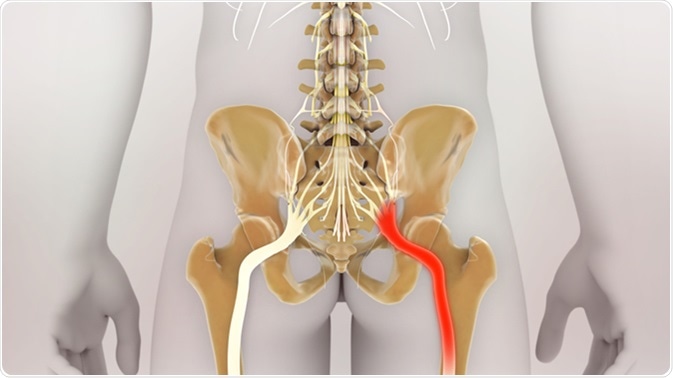Sciatica is a very common medical condition occurring at least once in up to 40 percent of the population. It is more common with increasing age, especially in people with back pain. Other risk factors include obesity, smoking and a sedentary lifestyle.

Sciatic Nerve Pain. Image Credit: Nathan Devery / Shutterstock
How does pain occur in sciatica?
The sciatic nerves are the largest nerves in the body, passing down from their origin in the lumbar spine to the buttocks, down each leg at the back, to the end of the big toes. The pain in sciatica occurs, when the sciatic nerves or any of their several roots are pinched or irritated. The pain may therefore occur anywhere along its path, in the lower part of the back, the buttocks, the leg, calf or foot.
The type of pain may also vary from dull aching pain, numbness, tingling or even something resembling an electric shock or sharp pain. The pain may be mild or so severe that even standing is impossible.
What treatment is useful in sciatica?
Treatment options in sciatica are limited, being mostly symptomatic. In many cases the episode is self-limited. Pain medications are often prescribed, and the application of ice packs in the first 72 hours is often helpful.
Steroids are not confirmed to be helpful. Surgery is often considered when the sciatica is due to a nerve root being pressed by a herniated intervertebral disc.
One thing that most people with sciatica fail to do is to get moving as soon as the acute pain subsides. The constant fear that the slightest movement will cause the pain to recur often limits all activity severely.
Without exercise, the joints and muscles tend to stiffen and lose strength. This hinders return to normal activity even after the pain lessens. Many patients fear that moving a painful part will harm their backs, but in fact, this is not true.
Why is exercise important in sciatica?
Most specialists agree that low-impact activity and exercise will actually benefit the condition. This is because regular exercise strengthens the weak muscles that support the spine, and prevent further herniation of the disc. The spinal spaces may actually widen as the muscles strengthen, giving the roots more room to pass without being pinched.
Proper exercise is central to managing an episode of sciatica. It ensures that muscle strength over the affected joints increases, while the joints also become more flexible. The pain is also relieved in most cases.
Exercises for sciatica: spinal stenosis | NHS
Tension in the nerves, which occurs with long-term pain around the spinal column, leads to the adoption of abnormal posture over time. As a result, the range of motion around the joints decreases, and joint degeneration sets in.
Muscle atrophy also occurs following chronic muscle shortening as a result of a lack of use. The muscles becomes thinner, with fewer muscle units, developing fibrosis and fatty degeneration of the tendons. In addition, joint ankylosis, cartilage atrophy and ligament malalignment may all develop, leading to a reduced range of motion. The outcome is limited functional movement for the patient, and joint stiffness.
This is why patients with sciatica must exercise and maintain a good posture, as well as a normal range of motion. Mobilization exercises are recommended to normalize muscle tone and keep the nerves more flexible.
With less pain during movement, there is greater freedom of movement and better muscle strength. The long term outcomes of exercise for the patients are also undeniably positive.
Research shows that patients who continue to rest in bed for more than two days following the onset of sudden severe back pain actually experience pain for a longer time. This is in comparison to those who get out of bed and get moving earlier. Therefore, the best advice for those with acute back pain is to continue with one’s normal activity, but avoid engaging in activities like heavy lifting or sitting in one position for a long time, which could exaggerate or bring back the pain.
Anti-inflammatory drugs may be taken regularly for a few days to facilitate exercise.
How should you exercise with sciatica?
Exercise in patients with sciatica may begin with gentle stretches, walking and mild exercises, performed for short periods of time. As it becomes more comfortable, the period of exercise may be increased little by little.
The types of exercise recommended for patients with sciatica include stretching, strengthening and aerobic activity. Doing such exercises every day, with the doctor’s consent, once an acute episode ends, may prevent further recurrences of the pain, or at the least, make episodes less painful and frequent.
Stretching reduces pain arising from the piriformis and hamstring muscles in sciatica.
Strengthening exercises firm up the paraspinal muscles that support the spinal column, as well as the ligaments and tendons around it, the abdominal muscles and the hip muscles. These may include the McKenzie exercises and Dynamic Lumbar Stabilization.
Mobilization of the joints affected by pain in sciatica is important in alleviating low back pain for the following reasons:
- Increased mobility
- Reduction in sensitivity to pain
- Better compliance (less resistance to movement) of the nerve tissues
The effects on the condition itself include the healing of damaged nerves, which results in:
- Less pain
- Better range of motion
- Better dynamic adaptability of the nervous system
Different types of exercise that may be useful in sciatica include:
- Biomechanical exercise, aimed at improving spinal movements – strengthening, stretching, motor control exercises like core stability or Pilates exercises, range of motion, McKenzie and Feldenkrais methods for specific movements that are painful or difficult
- Aerobic exercise for cardiovascular fitness, such as using a stationary bike or swimming, or water aerobics
- Mind-body exercises, such as yoga or tai chi
- Mixed modality exercise, which combines exercise from two or more of the other categories
Further Reading